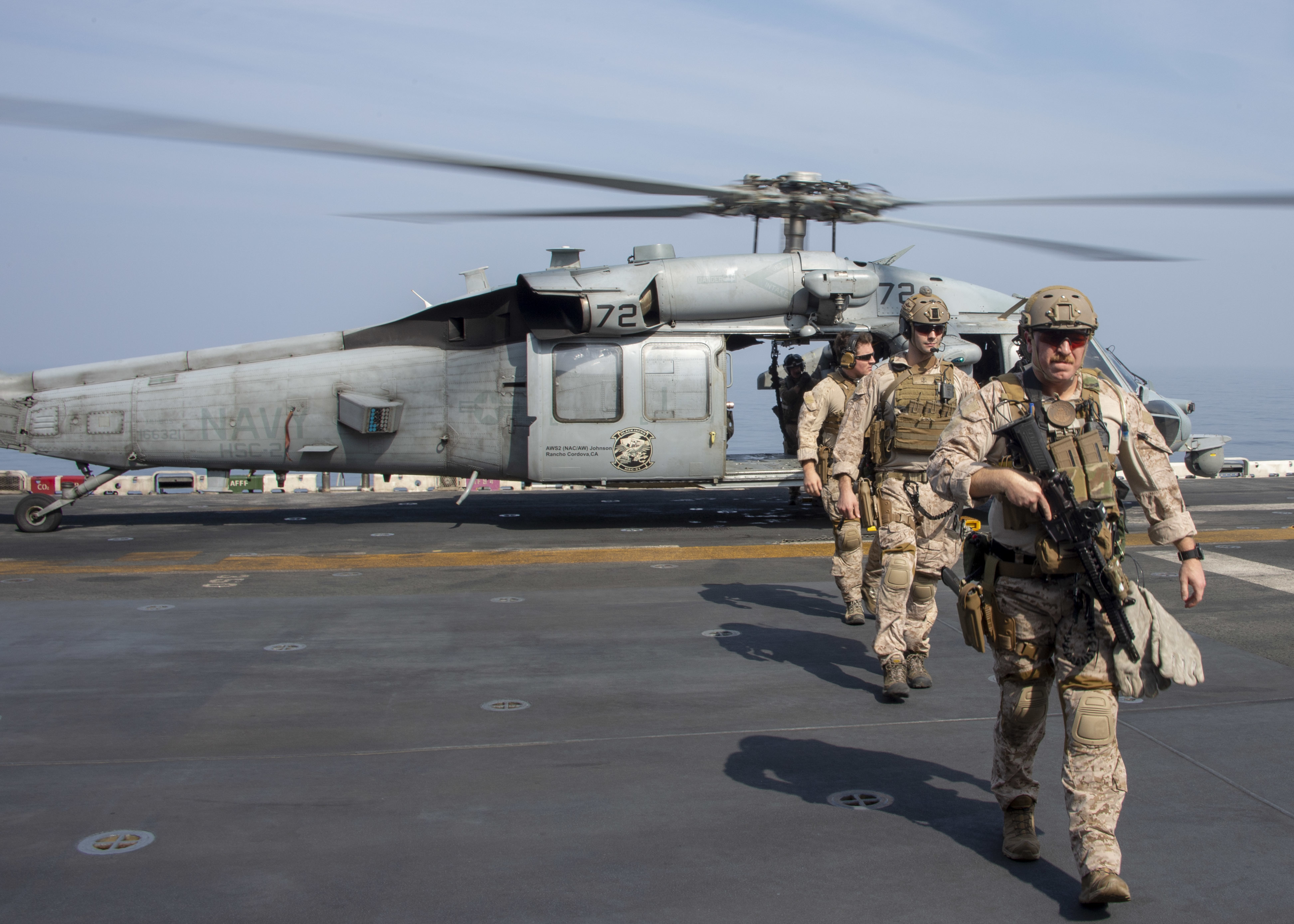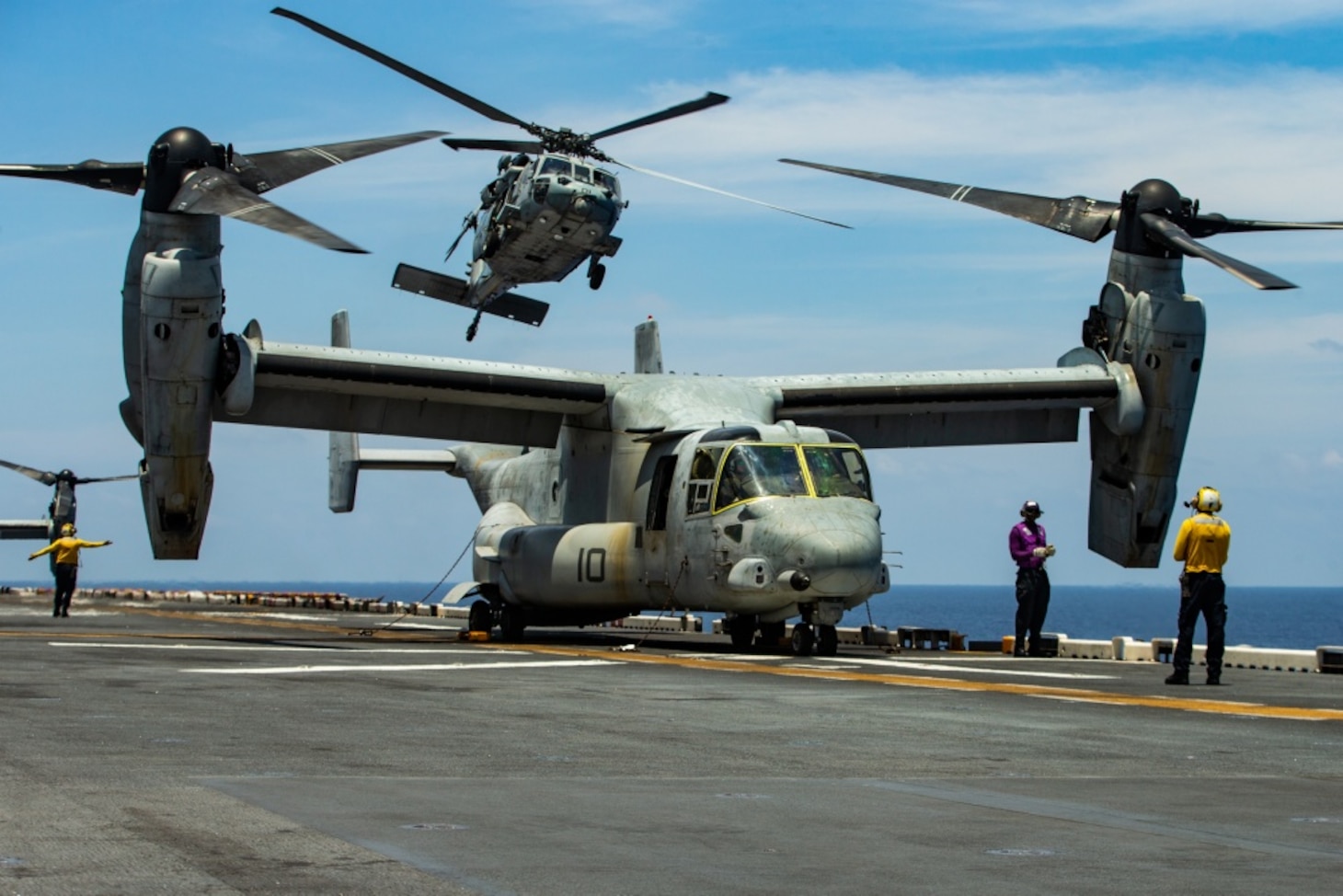Marine Corps Meu - The Marine Expeditionary Unit (MEU, "M'you" IPA: /m j uː / ) is the smallest airborne task force (MAGTF) in the United States Navy.
Each MEU is a rapid response force, ready to respond to a crisis in a timely manner, whether it is a natural disaster or a combat mission.
Marine Corps Meu
MEU strength is approximately 2,200 (civilian and peacetime) and 4,400 (mobilization and wartime). MEUs are usually commanded by a colonel and operated from an amphibious assault ship. Currently, the MEU deploys personnel and equipment to the amphibious assault group (ESG), which includes warships and submarines, to protect them from air, surface, and submarine threats. For added protection and strong air support, the ESG is often accompanied by one or more strike groups.
Commandant Of The Marine Corps And Smmc Visit 11th Marine Expeditionary Unit While Deployed > U.s. Indo Pacific Command > 2015
The MEU is unique in that it combines air and ground combat elements with a logistics combat element under a single commander; Other services do not integrate air and ground forces up to a higher level of command.
The ground combat element of the MEU integrates artillery, light armor, and tanks at a lower level than was common in the Army until the formation of a brigade combat team early in the war on terror. command etc. used in WW2.
This Air Force concept is designed to leverage existing combat power. Combined into a single force through close integration of air and ground forces. The MEU brings all the supplies and logistical support necessary to quickly complete a mission or open a path for follow-up forces. This independent sustainment allows for greater flexibility in force deployment and operation, allowing the MEU to quickly initiate operations and provide support later without having to wait for external logistics support to initiate the mission. Deploying a US Navy amphibious assault ship allows the MEU to establish a base that is ready for worldwide transport and short-term deployment.
A UH-1N of the 26th Marine Expeditionary Unit flies past an AH-1W on the deck of the USS Kearsarge.
Th Meu Marines Begin Rut > I Marine Expeditionary Force > News Article Display
As many types of equipment are replaced, they will be temporary or soon to be. Some examples include the missile-launched fighter jet that replaced the AAV-7, the F-35 Lightning II that replaced the AV-8B Harrier, and the CH-53K King Stallion that replaced the CH-53E.
Ground Combat Command (GCE) relies on Battalion Landing Teams (BLTs), infantry brigades supported by artillery batteries, amphibious vehicle commands, infantry commands, infantry commands, light armored road companies, patrol commands, and other units. And the situation demands. Total military strength is about 1,100 including marines.
Naval Special Forces are a subset of the MEU and are designed to perform the following tasks: Lower level. The MSPF consists of four units: an assault brigade (a direct action brigade augmented by a force examiner), a defense brigade (an infantry brigade selected from a battalion landing team), intelligence and surveillance assets, and a headquarters section. The total strength of the armed forces is about 350, including marines.

An aircraft combat element (ACE) is a USMC command (supplementary) consisting of heavy, light, and attack helicopter detachments, an aircraft carrier, an air-capable aircraft detachment, and a Marine Air Control Group. tactical air command, air traffic control, direct air support, and air defense equipment, as well as detachments with wing headquarters, liaison wings, and wing support personnel. The total military force is about 600 people.
Us Marine Corps (usmc) Marines From The 15th Marine Expeditionary Unit (meu) Special Operations Capable (soc) Maneuver On The Battlefield In Umm Qasr, Iraq, During Operation Iraqi Freedom
The Logistics Combat Element (LCE) (formerly the Service Combat Support Element or CSSE) is based on the MEU's Combat Logistics Battalion (CLB) (formerly the MEU Service Support Group or MSSG). It contains all the logistics experts and equipment necessary for the MEU to sustain itself and operate under extreme conditions for up to 15 days. These include service support (postal and payment), medical, dtal, intermediate maintenance, intermediate supply (consumer equipment and replacement), transportation (distribution and ground support), mine clearance, production and distribution, bulk fuel, internal communications, and . Other technical experts. It consists of about 300 members, including Marines.
The command element (CE), which includes the MEU commander and his support staff, provides command and control to the other three elements. Includes special equipment for Navy air gunnery communications, intelligence, surveillance, special communications, radio intelligence (SIGINT), electronic warfare, Marine Corps intelligence, counterintelligence, law enforcement, and public missions. It has a total of about 200 members, including Marines.
MEUs deploy to Expeditionary Strike Groups (ESGs) in the Mediterranean, Western Pacific, and occasionally the Atlantic and Indian Oceans. An ESG generally consists of 3 amphibious ships, carrying the necessary military forces and equipment, accompanied by a guided missile cruiser (CG), guided missile destroyer (DDG) and submarine support (SSN).
Marines with the 31st Marine Expeditionary Unit train aboard the amphibious assault ship USS Gray Bay (LPD-20) in the Philippine Sea in 2022.
Here's Why The Marine Corps Is Strapping Lavs To The Flight Deck
MEUs keep their sub-components on five-month rotations: nine months stateside (six of which are set aside for training), and six months aboard. These circuits allow at least two MEUs to move forward at any time.
Interim period or build-up period: After acclimatization, the MEU spends approximately one month on "special operations" and is ready for a global response. But they are not considered special operations units by the Ministry of Defense. The MEU was issued Major Sub-Elements (MSEs), retaining only command elements. This period allows the command to begin planning for rotations of selected personnel, newly assigned MSEs, and "on-the-job" training. After receiving the MFDS, the MES begins six months of preparatory training.
On-the-job training: The six-month on-the-job training is often referred to as "crawl, walk, run." Marines and Sailors advance through courses and exercises that teach individual, small unit, and unit tactics, integrating the disparate elements of the MEU into a cohesive, flexible, and dynamic force. The work phase includes training in a variety of combat and non-combat skills, including:

Implementation: After the operational period, the MEU operated for six months in support of the geographic combatant commander. During this period, the MEU is a dynamic and sustainable force that combatant commanders can direct to accomplish special operations and missions.
U.s. Marine Corps Maj. Brock Lennon, The Fire Support Officer With The 31st Marine Expeditionary Unit (meu) Observes The Maritime Interdiction Operation (mio) Training Exercise From Uss Germantown In The East China
The West Coast MEU is subordinate to Marine Expeditionary Force I, and its primary areas of operations include the western Pacific and the Indian Ocean (including the Persian Gulf).
The East Coast MEU is subordinate to II Marine Corps and maintains a presence in the Atlantic and Mediterranean Seas.
The 31st MEU is the only permanently deployed MEU in the Pacific as part of the 3rd Marine Expeditionary Force. In order to comply with the GDPR, we provide you with the latest version of the document. Collection, Use, Sharing and Protection of Your Information We want you to be aware of our updated Privacy Policy.
For many, the Marine Corps is defined by the fierce and bloody battles fought in the South Pacific during World War II.
Usmc Personnel Assigned To The 26th Marine Expeditionary Unit (meu), Camp Lejeune, Nc Take Up Defensive Positions Near An Amphibious Assault Vehicle (aav7a1) On The Beach At El Omayed, Egypt While Conducting
Today, these specialists in amphibious warfare and mobility are transitioning to mobility capabilities, threats, and capabilities. Marines are inherently mobile and have the characteristics of a "Marine Air-Ground Task Force" (MAGTF) and an "expeditionary" force.
One of the most consistent demonstrations of maritime operations (24/7/365) is seen in the ARG/MEU. The US Navy provides the Amphibious Ready Group (ARG), a special asset to facilitate amphibious transport operations.
The U.S. Navy ARG has a direct mission to send warfighters into theater. Images from Marine Corps literature show just how much power the ARG contains.
The Navy could add more resources to the ARG, create an Expeditionary Strike Group (ESG) or add a Carrier Battle Group (CVBG) — or both…
Nd Marine Expeditionary Unit
With 70% of the Earth's surface covered by water, ARGs offer the potential for high-power "bases" to transmit overseas near countries of interest. Smaller countries that don't have ocean scanning resources may not see them coming.
A more advanced enemy may realize an ARG/MEU is nearby and think twice about their actions. Admittedly, the ARG/MEU often finds itself in the news cycle during humanitarian operations or exercises with allied forces around the world.
Whether you see it or not, expect them to be at the center of a world crisis; Prevention of illegal transportation of weapons on board ships; Implementation of "elements" in support of ongoing military operations worldwide; Relocating Americans from troubled countries; Or a big drama war. If one wants to be in the center of the action, the US Marine Corps is a good place to start.
Ground Combat Element (GCE): 1st Battalion, 2nd Marine Corps (1/2) is an infantry battalion stationed at United States Naval Air Station Lejeune.
Marines Returning To Expeditionary Roots
MAW, MAG-26, Marine Corps Air Station New River, NC. The types of aircraft used are; AV-8B Harrier II, MV-22B, CH-53E, AH-1W and UH-1Y.
VMM-264 (Reinforced) is a dedicated component of the MEU ACE. Brought to you by ACE
Ruger 556 review, vg6 epsilon 556 review, msar stg 556 review, sinn 556 review, sinn 556 i review, meridian 556 review, eotech 556 review, precor efx 556 elliptical review, benchmade 556 review, surefire sfmb 556 review, precor efx 556 review, sinn 556 anniversary review


0 Comments